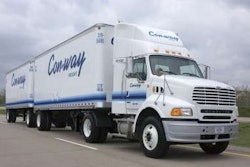Tractor, APU maintenance are not necessarily related
Most auxiliary power units (APUs) have lubrication and other systems that are separate from the rest of the vehicle. That means oil changes and other services may occur at intervals unrelated to regular tractor maintenance intervals. What is the best way of managing and – if possible – synchronizing APU maintenance intervals to minimize shop visits?
“APUs often introduce fleets who haul dry freight to the maintenance problems reefer fleets face – ‘Welcome to my world’,” says Bud Radowick, manager of fleet performance at Thermo King, and a veteran maintenance manager for a refrigerated fleet.
Radowick’s job is to help fleets using Thermo King equipment understand their maintenance costs. “Our APU maintenance intervals, which are in hours, normally do not correspond with the tractor maintenance intervals,” he says. “You need to do your maintenance based on APU hours, not tractor miles.”
Tom Kampf, APU product manager at Thermo King, says an APU’s basic oil and filter change interval is 1,000 hours. The other intervals are at multiples of this, with a check of refrigerant system operation and an overall look at the unit – mounts, belt tension and condition, and so forth – at 500 hours, and the secondary fuel filter change at 2,000 hours. The primary fuel filter and engine air cleaner are changed based on inspection.
Radowick believes a fleet’s focus regarding APU maintenance should be on reducing costs, and not necessarily on reducing visits to the maintenance shop. “Very often, synchronizing APU maintenance with the rest is ‘Mission Impossible’,” he says. Lease fleets focus on limiting shop visits, so their tendency is to change the oil and filters prematurely and force a synchronization of service intervals, Radowick says. “You waste more on oil and filters than it costs you to make the extra maintenance stop,” he says.
Radowick says a big-picture view can reveal how having APUs may lower overall maintenance costs. Thermo King has found that an effectively used APU often yields a reduction in idle time from 15 percent and more to as little as 5 percent. Fleets with APUs commonly extend oil changes from 20,000 to 30,000 miles, carefully sampling the oil along the way. “Fleets that have increased their oil change intervals have not regretted the decision,” he says. “The oil is often cleaner than it was before they started using the APU, even with the increase in miles between changes.”
Radowick’s claim is reasonable. Oil and engine experts constantly are railing against the evils of idling a diesel truck. At idle rpm, combustion efficiency is poor because injection pressure drops and the combustion chamber fails to create enough air motion. Piston rings seal poorly because it takes turbocharger boost and full firing pressure to force them outward against the liner so they will operate as designed, increasing blowby. When at low idle in cold weather, coolant and oil temperatures may drop well below operating levels, increasing the oil’s absorption of moisture and unburned fuel from the blowby gases.
APU-equipped tractors at trade often have seen a sharp decrease in idle time – as much as 30,000 hours. While the market may not yet fully appreciate the difference, smart fleets or owner-operators purchasing used trucks are likely to see the enhanced value of a used truck that’s been shut off more frequently. Those who may choose longer trade cycles during the coming months also could benefit from the improved condition of their engines.
Not everyone agrees that it’s a bad idea to synchronize intervals, however. “For an APU with a 1,000-hour service interval, there is plenty of flexibility for synchronizing service with the truck’s service schedule,” says Eduardo Andrade, Carrier Transicold’s director of business development. In typical long-haul operations, 1,000 hours of APU use equates to about six months, so at that rate, service will be needed twice a year, Andrade says.
“For a fleet, this may mean doing the APU service every other time the truck is in for its routine service,” he says. “That, of course, depends on the mileage of the truck, how hard it’s driven, the type of oil used, and the frequency of changing it. But the bottom line is that there is plenty of room for flexibility so that you don’t need to schedule a special stop just for APU service.”
Carrier’s manual recommends at the same 1,000 hours an inspection of belt tension, checking all exhaust system and cooling system hose clamps, changing the engine fuel filters, and an inspection and cleaning – if necessary – of the A/C system’s air filters; they also recommend an automatic replacement of the cooling fan belt. More basic checks – including generator output voltages, injection nozzle opening pressure and pump timing – come at 2,000 hours.
J.D. Kruger – vice president of Auxiliary Power Dynamics, makers of the Willis APU – says his company’s oil change interval is 500 hours. Kruger says they have tested the recommended CJ-4 oil with satisfactory results up to 1,500 hours and are considering extending the interval, and that he is confident there is flexibility available. Fuel and air filters are changed with the oil.
Accessibility also is part of APU shopping from the maintenance manager’s point of view. The APU’s cooling system often is linked to the truck’s cooling system, eliminating its engine coolant as a separate maintenance item and helping eliminate cold starts of the truck engine in winter. However, technicians and drivers need to be trained to bleed the APU’s cooling system whenever refilling the main engine’s system after draining or a major leak; failure to do this could easily allow the little diesel to overheat and need a premature overhaul.













